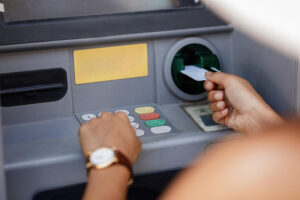Managing finances as a sole proprietorship is crucial for running a successful business. A business bank account makes it easy to track company funds while offering additional services to help your venture grow. Read on to learn how to open a sole proprietorship bank account in four simple steps.
>>>Use Lili to open your business bank account in minutes!
How to Open a Sole Proprietorship Bank Account In 4 Steps
There are no shortcuts when it comes to opening a sole proprietorship bank account. The following steps show you everything you need to set one up quickly.
Step 1. Decide on a Business Bank Account Type
Your sole proprietorship may benefit from a few different bank accounts, depending on your business focus. Here are the most common bank accounts to choose from.
Business Checking Account
A business checking account will likely be the most important account you use as a sole proprietor. This account lets your business freely move funds, accept deposits from outside sources, and make necessary payments.
Whenever you need to withdraw money from your bank, the business checking account is probably the first place you’ll go. It’s essential to always keep enough money here so you don’t end up with an overdraft.
Some banks are more liberal than others with how many transactions you can do in a given month. If faced with limited transactions, you’ll want to plan ahead to avoid fees. Capital One is one of the few institutions that allow unlimited digital transfers.
Business checking accounts may offer interest on the cash you’re keeping within. While a nice perk, such a perk is far from the norm. Bluevine is one of the few to step up here, giving up to 2.0% APY on up to $100,000.
Business Savings Account
If you’re able to maintain a healthy balance in your checking, a business savings account may be an option for you. These accounts work well for unexpected expenses or saving up for a large purchase down the road.
Unless a bank is a real dud, any money kept in a business savings account accrues interest at an advertised rate. You get to do business as usual and have the bank pay you a small amount on the side.
The amount you earn in a savings account often scales depending on how much you have within. Higher amounts generally increase the interest rate, assuming you can afford to set aside that much cash each month.
You’ll need to be careful about taking funds out of your savings account, though. It’s only possible to withdraw money six times per month, potentially leaving you in a pickle if you don’t plan well. Most banks won’t let you write checks or use a debit card to pull money from your savings, either.
Business Money Market Account
Business money market accounts function like savings accounts but come with a handful of additional perks. You can usually find higher interest rates here while being able to write checks or use debit cards to draw out cash as needed.
This flexibility can come with a literal cost, as money market accounts often charge unavoidable fees. If there’s a way to waive fees, it will be through high monthly balance requirements. There’s usually a large initial deposit to open an account in the first place.
Business Certificate of Deposit (CD) Account
Business certificate of deposit accounts are the cream of the crop for earning interest but are very rigid by design.
When you open a CD account, you agree to leave that money alone for a certain period of time. Known as the term of the CD, this interval can range from months to years.
Generally speaking, the longer the duration of the CD, the more interest the account will earn. The amount of money you’re able to put in is also a significant factor.
Before using a CD account, make sure you’re setting aside money you won’t need for any reason. You’ll be penalized heavily for withdrawing funds from a CD and likely lose out on whatever benefit the account offered in the first place.
Merchant Account
Sole proprietorships wishing to accept credit or debit card payments from customers will need a merchant account. These accounts act as a temporary holding location for these funds before finding a permanent home among your other accounts.
The bank or point of sale service you choose for your merchant account may have hardware or software you’ll need to install before accepting payments. Check for associated one-time or recurring equipment fees before signing up. In addition, be prepared to have the service take a small transaction fee each time a customer swipes their card.
Contracts for a merchant account typically run between one and three years in length. You can’t take payments from plastic without one, but some point of sale options are better than others.
Step 2. Find the Ideal Bank
With knowledge of the available account types, you can now start looking for the optimal bank for your sole proprietorship. Keep the following factors in mind when searching so you don’t incur unruly expenses or miss out on a feature your business needs.
Fees
Banks choose to earn their keep in different ways, but these always spell fees for the customer. These fees can be anything from monthly service charges to costs for using certain services.
Don’t be too shocked if the majority of the banks you look at have regular maintenance fees for account upkeep. The best bank accounts have ways to waive these charges by meeting specific requirements. Lili and Axos are among a few online options advertising completely free business banking accounts.
Most business checking accounts place limits on transactions and cash deposits. Exceeding these limits will result in per-transaction fees that can add up very quickly. Being mindful of your money flow can help avoid penalties here.
Charges can appear for out-of-network ATM use or wire transfers going either way. Banks may offer some business services for free while assigning costs to others. Be sure to read all the fine print so you know what you’re getting yourself into.
Required Minimums
As you start your journey with a bank, you may have to put down an initial deposit. Accounts with higher initial deposit requirements tend to offer better perks, so you may have to save up a bit if you want a particular account.
After you’re up and running, the bank may ask you to keep a minimum monthly balance. If you can’t keep enough money in your account, you’ll have to deal with monthly fees you may not be able to afford. Accounts requiring higher balances may seem appealing, but make sure your sole proprietorship can keep up with demands.
Your balance may also play a role in the interest rate you’ll earn in your savings, money market, or checking account. In general, more money unlocks higher rates to supplement income from your customers.
Interest Rates
Every penny matters when running a sole proprietorship. If you’re able to set aside a rainy day fund, you can use a savings or money market account to earn some interest on cash you already have.
Interest rates vary from bank to bank, with some offering as low as 0.01% APY for those just starting out. If you shop around, it’s possible to find a higher introductory rate. The national average sits at 0.35%, but many banks require high balances to reach such a number.
Online Banking
Long gone are the days of stuffy traditional banks with sparse locations and long queues. Today’s institutions embrace the ability to perform most, if not all, of your financial operations online.
Whether via the web or an intuitive mobile app, it only takes a few button presses to send money, request a transfer, or view your account balances. Many banks allow you to deposit checks using your phone’s camera.
Some online banks can get away with lowering fees by eliminating physical locations altogether. Should you need to locate an ATM or a branch, the mobile app can show you the way.
Having this flexibility with your finances enables you to bank on your time, allowing you to focus on your business instead. If a bank doesn’t dabble in online banking, it may not be worth doing business with.
Business Services
Banks use business services to stand out among the competition. Top offerings include fraud protection on your account, payroll solutions, or lending options to lock in that big purchase. The sky’s the limit, so look around for features that work for your sole proprietorship.
Others may hand out sign-on bonuses for becoming a member or a rewards system with perks depending on how often you bank. If you run an e-commerce business, banks like Novo integrate with Shopify and Etsy to facilitate your cash flow.
Ease of Use
Lastly, don’t forget to consider how easy a bank is to work with. Check customer service hours and read reviews to get a feel for how a bank operates. Clunky or outdated web interfaces or apps can wreak havoc when you’re trying to shift funds before a big expense hits.
Step 3: Gather Your Documentation
After selecting a bank, you’ll need to gather your business’s documentation to open your account. No two banks are the same when it comes to paperwork, but bringing the following for a sole proprietorship should suffice:
Business Name and Address: You must show the bank your sole proprietorship’s legal name and the address you do business out of.
Doing Business As Certificate: Sole proprietorships use the owner’s first and last name as the company’s legal business name. If you want to do business under a different name, you must request permission from the local governing body. You’ll receive a “doing business as” certificate allowing you to run your store under another name.
Social Security Number or Employer Identification Number: Sole proprietors can open a bank account using their social security number (SSN) for tax purposes. Alternatively, you can request an employer identification number (EIN) for free from the IRS. Using an EIN helps differentiate business dealings from your personal assets.
Business License: Once your business becomes official, you’ll receive a business license permitting you to operate in a particular area.
Government-Issued Photo ID: You’ll need to prove you are the legitimate owner of your sole proprietorship with a photo ID. This can be a passport, driver’s license, or the like.
Personal Information: Alongside your ID, you’ll need a certificate with your name and date of birth.
Step 4: Apply for an Account
With research complete and documents in hand, it’s time to apply for your account. Most of the time, the process is relatively painless and can sometimes be completed online.
Otherwise, you’ll need to visit a local branch with your documents in tow. A banker will pore over your application and make sure everything checks out. It’s worth contacting the bank before you arrive to ensure they’re not looking for out-of-the-ordinary paperwork.
Most banks will set up your account right on the spot, but others can take a few business days to get everything in order. Although uncommon, some institutions may request a credit report.
If signing up online is an option, you’ll have to submit all your documents through the bank’s secure portal. Fintech companies like Lili cut the processing time down to a few minutes so you can start doing business right away.
You’ll also want to bring a check or have the means to transfer funds into your account if a bank has an initial deposit requirement.
Why Sole Proprietorships Should Open Business Bank Accounts
There’s no law requiring a sole proprietorship to open a business bank account, but it’s still a good idea. Here are some of the top reasons to have an account solely for your business.
Access to Financing
Your sole proprietorship may someday need a loan or other form of business financing. Lenders typically require you to have a business checking account to verify how much money flows through your venture in a given month. If you can’t prove you have the means to pay back your loan over time, you won’t receive one.
Professionalism
Having a business bank account in your company’s name looks very professional in the eyes of potential customers or business partners. With so much distrust on the internet, shoppers may think twice about sending money to a personal bank account. You can also use business dealings to promote your company instead of just your name.
Simplifying Tax Time
Preparing your business taxes is a challenging process, and not having clear lines between personal and business expenses just complicates things more. It will be much simpler to know what you owe when all your sole proprietorship’s dealings pass through one account. Any grey areas won’t look good on paper and could give the IRS a reason to audit your finances.
Proper Bookkeeping
As a business owner, you need to track all incoming and outgoing funds to know how your company is faring. Not being aware of whether your business is in the red or black is a recipe for disaster. A separate bank account for your business allows you to follow all this data in one place.
Credit Card Payments
With a business bank account, you can accept credit and debit card payments from your customers. Without one, you’ll have to devise other methods to get paid for your products or services.
Open a Sole Proprietorship Bank Account Frequently Asked Questions (FAQs)
Want to learn more about opening a sole proprietorship bank account? This FAQ may have the answers you’re looking for.
Bottom Line on Opening a Sole Proprietorship Bank Account
While not a requirement, opening a sole proprietorship bank account is a wise business decision. Handling your business dealings apart from personal finances should help you immensely in the long run. Luckily, starting one is as simple as figuring out which accounts you need and finding the bank with the features you’re looking for. Once you’re ready, collect your business documents and sign up in person or online.
>>>Try Bluevine today for fee-free banking with an incredible interest rate!
Best Business Bank Accounts by State
Below you will find an interactive U.S map that can help you locate and compare different banks and financial institutions that offer business accounts in your area.















